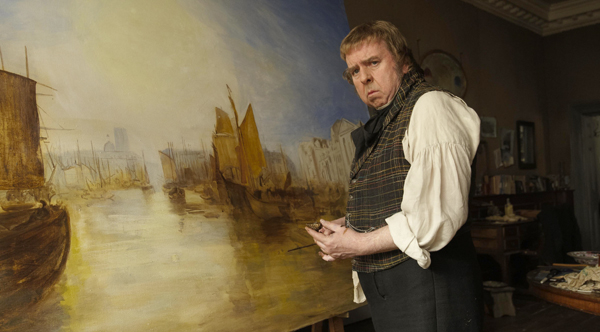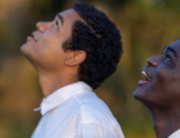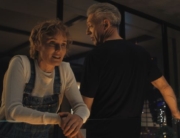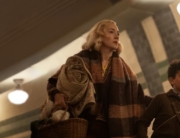In the awards competition at the Cannes Film Festival, two films rejuvenated the often clunky genre of the biopic. Mike Leigh, whose films have won many honors here, offered something of a departure from his previous output. Mr. Turner, appropriately his most picturesque film yet, explores the later years of pre-Impressionistic, pre-rebel chic painter J.M.W. Turner.
As in Topsy-Turvy, Leigh replicates the Victorian age through a contemporary filter, addressing, as usual, the rigidity of the class system and how one man, a megalomaniac, treats those around him, especially women. Rather than attempting to paint a large, unwieldy by-the-numbers portrait, the to-the-point screenplay provides a sketch of Turner’s imagined life and times.
More so than Leigh’s other films, Mr. Turner is boldly melodramatic and stentorian. Whereas Topsy-Turvy revolved around staging a Gilbert and Sullivan operetta, here the life of Turner (Timothy Spall) takes the spotlight, literally, when the now-famous Turner sees himself lampooned onstage in a revue. His reaction: confusion, though it’s sometimes hard to scrutinize the growling painter’s expressions. Not caring a whit for social graces, he habitually wears a scowl, looking as though he’s just ingested a particularly sour pickle.
The characters are almost all theatrical archetypes: the wronged and aggrieved mother (Ruth Sheen) of his two illegitimate daughters; the historian/mama’s boy John Ruskin (Joshua McGuire, cue laughter), with his affected, fey mannerisms and speech; the cowering and simple-minded maid Hannah (Dorothy Atkinson); and the coldly disdainful Queen Victoria (Sinead Matthews). She declares Turner’s paintings “vile” and one in particular “a dirty yellow mess.” Many in Leigh’s acting repertory pop up—Timothy Spalding, in a lead role for a change. For international audiences, the choice find among the broad-stroked characterizations is Marion Bailey as Mrs. Booth, Turner’s patient and self-deprecating common-law wife.
Leigh places viewers right in the middle of Turner’s domestic and professional matters—no art history degree necessary. It will become apparent why his more abstract approach to painting made Turner stand out from his contemporaries. Dick Pope’s cinematography suggests rather than represents the colors and light that fascinated the artist and permeated his paintings.
Although a few scenes are beautifully filmed by the seaside or at the countryside, Leigh touches upon darker details of mid-19th century life, or at least takes liberties in his screenplay to fill in the blanks for what is not known about Turner and his circle. Namely, there’s the lecherous portrayal of the master-servant relationship, in which any number of today’s employment laws are broken. Turner’s put-upon domestic, Hannah, wears filthy rags, looking like she has never touched a bar of soap in her life.
Yet the film is not strictly a deconstruction of Rule Britannia—the bio also underscores the belief that art should be free and available to all. If there is a climax in this episodic film, it occurs when Turner refuses the huge amount of money Sir John Sloane offers him for his artwork, instead bequeathing his paintings to the British nation, mostly through Tate Britain. Even the film’s title bestows a touch of the man-of-the-people status on the country’s (perhaps) most influential painter. Through Turner, Leigh has it both ways: he’s tough on British history, but there’s still a bit of Heritage England seeping through.
Yves Saint Laurent, the purveyor of haute couture and ready to wear, is now the subject of two recent French films. The first one out of the gate, Yves Saint Laurent, directed by Jalil Lespert, is now playing in theaters in the United States. It’s bland and downscale compared with Bernard Bonello’s trippy Saint Laurent, which premiered at the festival.
It will be difficult for almost any mainstream work to overtake this film when it comes to debauchery. It was the guiltiest pleasure of Cannes, beautifully filmed and intoxicating. (Bonello’s biopic was in preproduction when the rival film was announced, which beat Saint Laurent to the screen by several months.)
Bonello (House of Pleasures) is one of the few filmmakers who deserves the label provocative. His version is audacious and a bit snarky, delving into the designer’s 1970s excesses without restraint: blue pills, cocaine, rough trade! Names are dropped—Andy Warhol, Karl Lagerfeld—and so are the pants. Once the chronologically shuffled film arrives in the 1970s, the party really gets started. YSL is mostly talk; Saint Laurent takes action.
In the former, the designer is played by the soft-spoken, bird-like Pierre Nimey. In the latter, the slim bon vivant has swagger, played by a game Gaspard Ulliel. Though Bonello’s film is more than an hour longer, it covers less time, Saint Laurent’s prime years, 1967 through 1976. Lespert’s film goes back to his rise as Christian Dior’s assistant in the late 1950s, plot point by plot point. It could have been subtitled The Early Years.
Saint Laurent’s life and business partner, Pierre Bergé, fully cooperated with the filmmakers of YSL but blocked the house’s cooperation with the Bonello film. He’s right to be worried. Saint Laurent is the least fawning or ennobling biopic of some time, but it doesn’t depict anything that hasn’t been alluded to or discussed in previous documentaries.
In L’Amour Fou, Bergé was accessibly forthcoming about their private lives, which were unconventional, not the least because they were publicly a gay couple before Stonewall. Two other documentaries stressed Saint Laurent’s work ethic, Yves Saint Laurent: His Life and Times and the verité Yves Saint Laurent 5 Avenue Marceau 75115, which was centered inside his design studio. To Bonello’s credit, viewers feel the urgency of the constant deadlines, and at times Saint Laurent feels like a workplace drama.
In the long run, the film proves Saint Laurent wrong. He believed fashion may be as “fleeting as advertising,” but his late 1960s output is classic, tried and true, inspired to a large extent by movie goddesses like Dietrich, Harlow, and Garbo. The film, however, cheekily points out the gap between fantasy and the tumult of the times via split screen: one side reveals the latest ’60s runway fashion while the other shows news footage from May 1968 and the ensuing war protests.
Not without empathy, Saint Laurent also offers one of the most revealing examples of the isolation of a high-profile figure, enabled by his ego boosting flunkies, in this case his muses Betty Catroux (the stunning, long-legged blond Ayneline Valade) and Loulou (Léa Seydoux). Saint Laurent surrounds himself with obedient women who won’t contradict him, a gay man on top of the male hierarchy. Calming the petulant man-child and cleaning up his messes: that’s Pierre’s job.
This is the sumptuously languid film that a hungover Bob Fosse would have made. It’s as hallucinatory and introspective as All That Jazz and a mirror image of that autobiographical film of the let-it-all-hang-out era, in addition to being a warts-and-all addiction film. Moody, seductive, flashy: ambiance is all.
Mr. Turner opens in December, Saint Laurent in 2015.








Leave A Comment